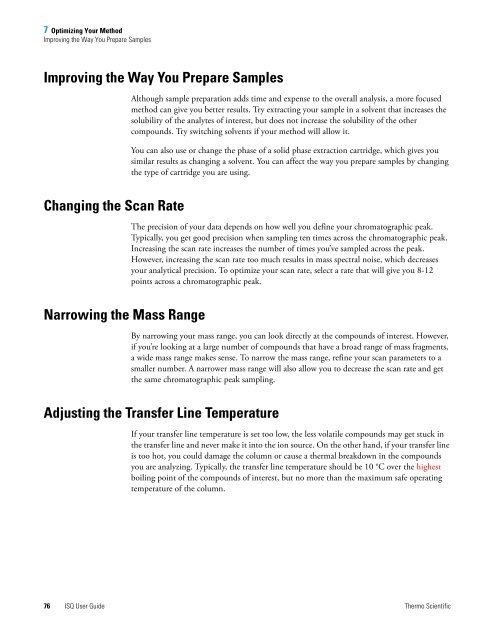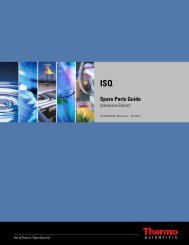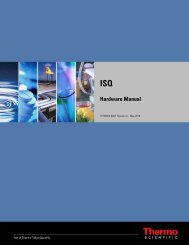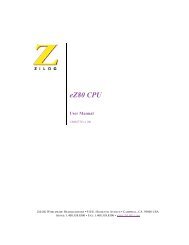ISQ User Guide - Write Frame of Mind
ISQ User Guide - Write Frame of Mind
ISQ User Guide - Write Frame of Mind
You also want an ePaper? Increase the reach of your titles
YUMPU automatically turns print PDFs into web optimized ePapers that Google loves.
7 Optimizing Your Method<br />
Improving the Way You Prepare Samples<br />
Improving the Way You Prepare Samples<br />
Changing the Scan Rate<br />
Narrowing the Mass Range<br />
Although sample preparation adds time and expense to the overall analysis, a more focused<br />
method can give you better results. Try extracting your sample in a solvent that increases the<br />
solubility <strong>of</strong> the analytes <strong>of</strong> interest, but does not increase the solubility <strong>of</strong> the other<br />
compounds. Try switching solvents if your method will allow it.<br />
You can also use or change the phase <strong>of</strong> a solid phase extraction cartridge, which gives you<br />
similar results as changing a solvent. You can affect the way you prepare samples by changing<br />
the type <strong>of</strong> cartridge you are using.<br />
The precision <strong>of</strong> your data depends on how well you define your chromatographic peak.<br />
Typically, you get good precision when sampling ten times across the chromatographic peak.<br />
Increasing the scan rate increases the number <strong>of</strong> times you’ve sampled across the peak.<br />
However, increasing the scan rate too much results in mass spectral noise, which decreases<br />
your analytical precision. To optimize your scan rate, select a rate that will give you 8-12<br />
points across a chromatographic peak.<br />
By narrowing your mass range, you can look directly at the compounds <strong>of</strong> interest. However,<br />
if you’re looking at a large number <strong>of</strong> compounds that have a broad range <strong>of</strong> mass fragments,<br />
a wide mass range makes sense. To narrow the mass range, refine your scan parameters to a<br />
smaller number. A narrower mass range will also allow you to decrease the scan rate and get<br />
the same chromatographic peak sampling.<br />
Adjusting the Transfer Line Temperature<br />
If your transfer line temperature is set too low, the less volatile compounds may get stuck in<br />
the transfer line and never make it into the ion source. On the other hand, if your transfer line<br />
is too hot, you could damage the column or cause a thermal breakdown in the compounds<br />
you are analyzing. Typically, the transfer line temperature should be 10 °C over the highest<br />
boiling point <strong>of</strong> the compounds <strong>of</strong> interest, but no more than the maximum safe operating<br />
temperature <strong>of</strong> the column.<br />
76 <strong>ISQ</strong> <strong>User</strong> <strong>Guide</strong> Thermo Scientific






